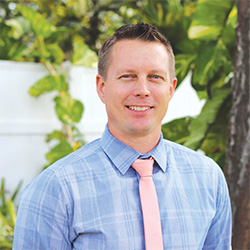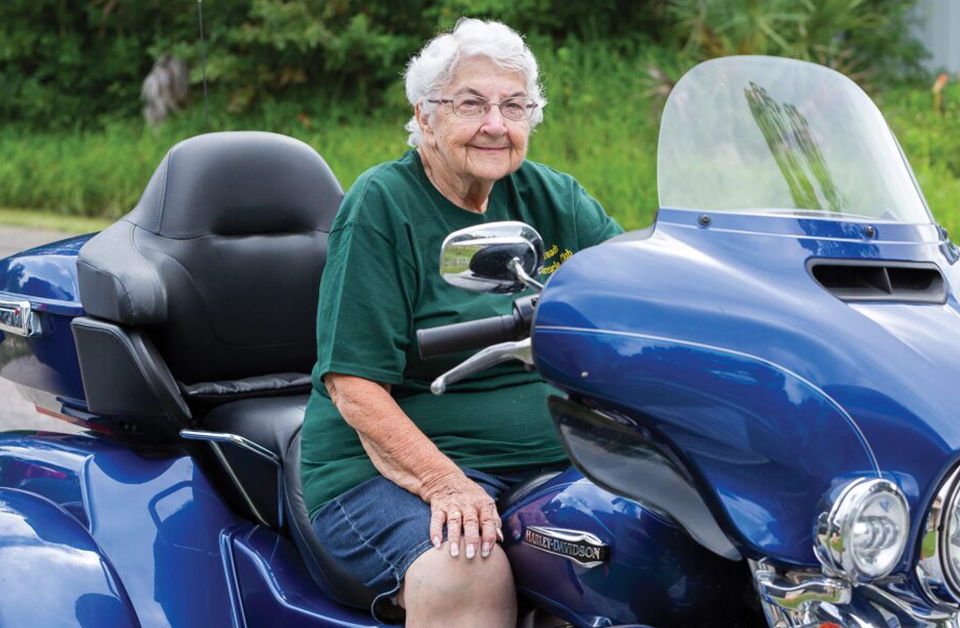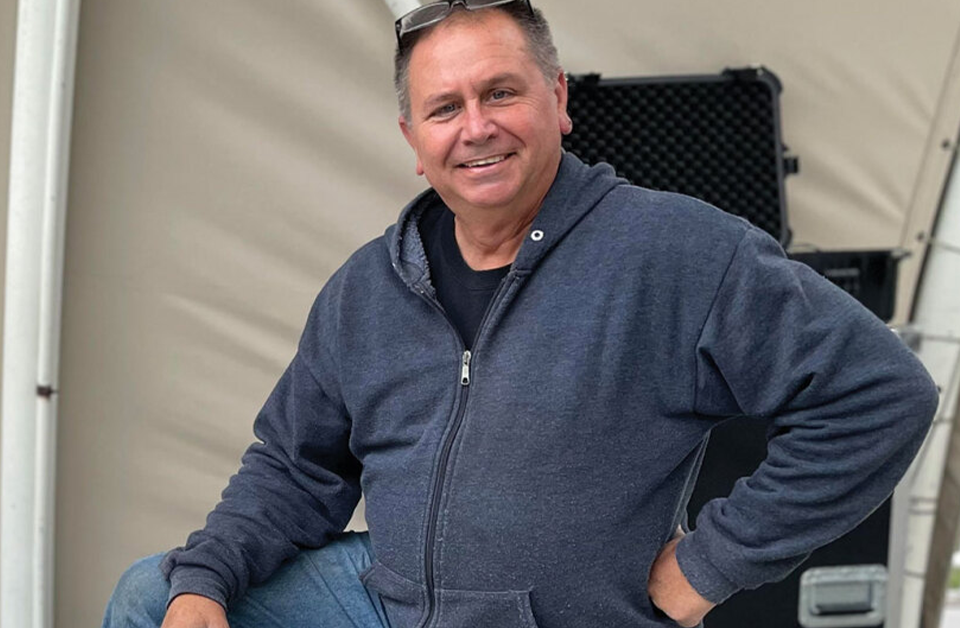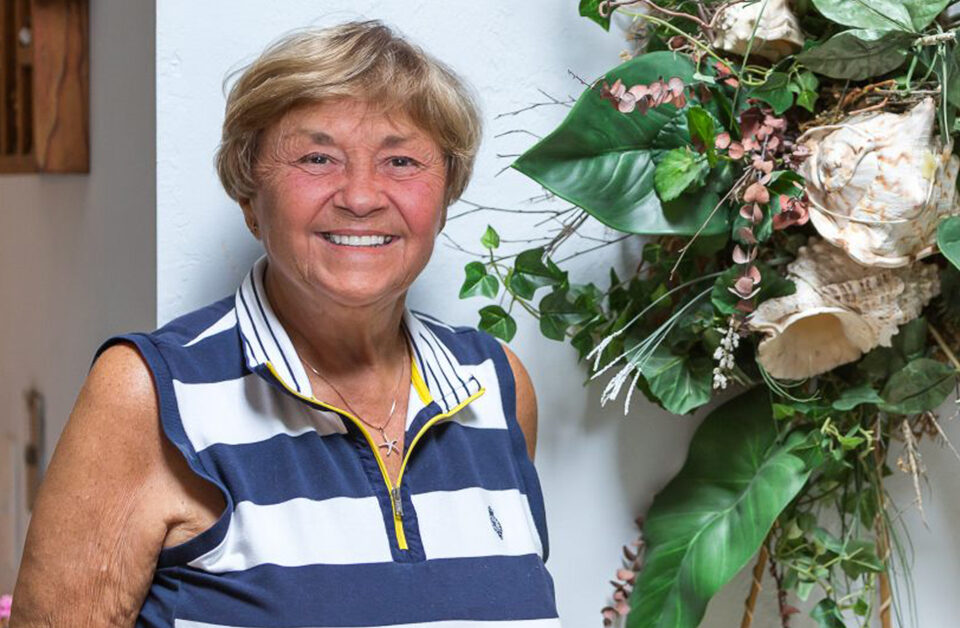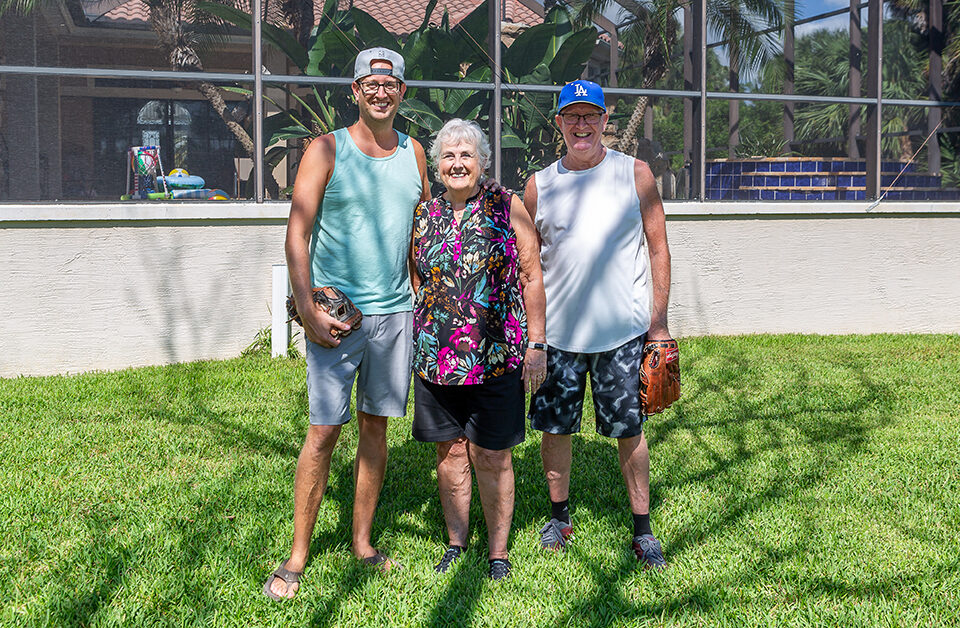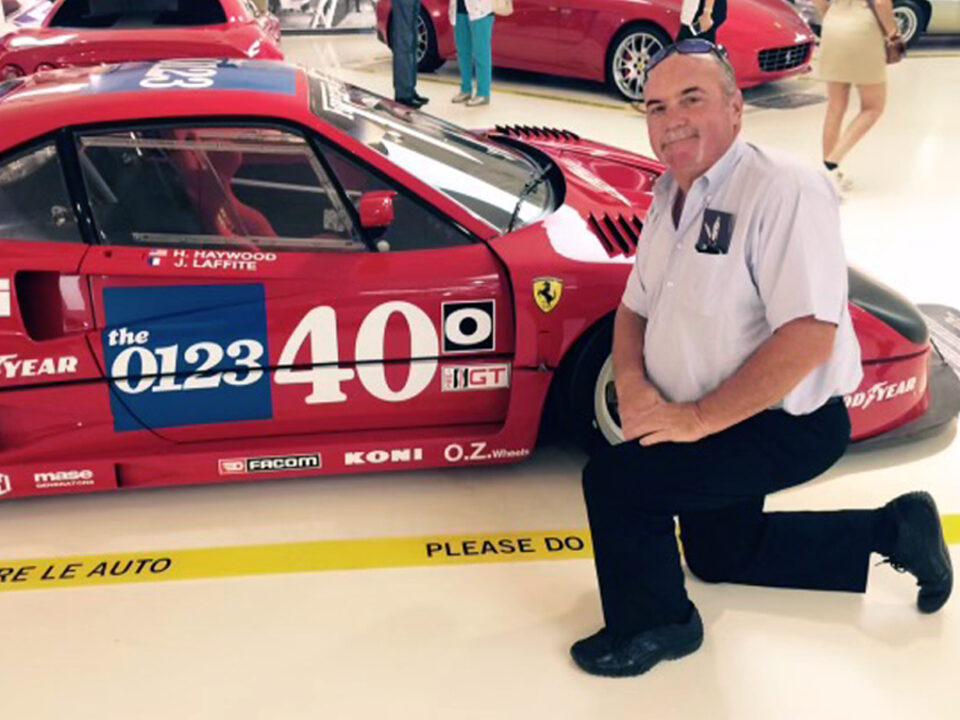

Jordan Pysz / ifoundmydoctor.com
A comprehensive treatment plan for peripheral neuropathy is allowing Nancy to enjoy life on the farm again. Three weeks into the protocol, her pain lessened and her arm strength improved enough to saddle her horse again.
If the raccoons had left the chickens alone, Nancy Belflower would still have her hands full on the five-acre farm that she “retired” to 10 years ago. Thanks to the raccoons, though, she’s got just enough to do to keep her from being bored.
“I have a horse and a donkey, five feral cats that live outside, a cat that lives inside and two dogs,” Nancy reports. “The cats are all fixed, thankfully, but with all that and a garden full of kale, garlic, tomatoes and a bunch of different herbs, I stay pretty busy around here.”
Nancy, 68, would rather be busy than bored, especially if her workload requires taking care of animals. Since she was a child, Nancy has had an affinity for animals of all kinds. Or maybe it’s the other way around.
“Back when I was in grade school, dogs used to follow me home from school,” Nancy relates. “They eventually went back home, but they used to follow me all the time. One day, a Great Dane followed me home. My mom wasn’t very happy about that one.
“Ever since then, though, I’ve always loved animals, and for years I worked with animals. I worked for a veterinary clinic and was an animal control officer for a couple of years. I’ve also done a lot of pet sitting and things like that. Now, I just take care of my own animals.”
Not long ago, those chores became more difficult for Nancy. The reason: a flareup of peripheral neuropathy, a condition that damages the nerves outside the brain and spinal cord and disrupts the flow of blood mostly to the feet, hands and arms.
Peripheral neuropathy can cause weakness, numbness, tingling, burning and pain in the areas it affects. It’s most often caused by diabetes but can be triggered by injury, chemotherapy, heavy drinking, smoking and exposure to some medications.
Indeed, research shows that people taking statins are 17 times more likely to develop peripheral neuropathy. Nancy’s condition developed as a byproduct of fibromyalgia, a musculoskeletal disorder characterized by pain, fatigue and other symptoms.
“I’m not diabetic and I’m very active, so when this neuropathy really started to become a problem for me, my doctors were very puzzled by it,” Nancy explains. “They eventually determined that it was caused by the fibromyalgia.
“Whatever the reason, I can still remember the first time I ever experienced a problem with it. It was in 1997, and I was out walking. Then, all of a sudden, I felt this zap like an electrical shock in my right foot.”
In the years since then, Nancy’s condition steadily worsened. She went from feeling an occasional “zap” in her right foot to experiencing a longer-lasting tingling sensation in that foot. Then, about five years ago, her legs began to throb incessantly, mostly at night.
“But that wasn’t the only problem,” Nancy laments. “Every once in a while, I would also get that feeling that somebody shocked me in my legs, and that would make me jump. Then, last year, I started to get that same feeling in my arms.
“My arms also started to feel very weak. They were so weak that I couldn’t even saddle up my horse to ride it. I wasn’t really riding all that much because I hurt so much, but not being able to put a saddle on my horse was kind of the last straw for me.
“I had been to my regular doctor and even a neurologist before that, but all they wanted to do was put me on more and more medications. I was already taking gabapentin, but that made me drowsy, so I started looking for something else.”
Nancy says a friend prompted her pursuit for an integrative treatment, although the search wasn’t scientific.
Nancy simply surfed the internet, which led her to Coastal Integrative Healthcare and Timothy Steflik, DC, the practice’s clinic director and president.
Neuropathy Stages
Coastal Integrative Healthcare provides pain relief through advanced chiropractic equipment, advanced technology and regenerative medicine therapy. It also specializes in the treatment of peripheral neuropathy, which has four stages.
In Stage 1, patients feel occasional tingling, numbness and pain. In Stage 2, the tingling, numbness and pain are felt more often. In Stage 3, the pain becomes constant and intensifies to a point where it begins to affect balance and mobility.
In Stage 4, patients begin to lose feeling in their feet, hands or toes, and begin to develop wounds that are slow to heal. At this stage, the risk for amputation greatly increases because of the irreversible damage caused by a lack of blood supply to the affected nerves.
At Coastal Integrative Healthcare, the stages are determined largely through a physical evaluation.
“As it was with Nancy, most of the patients we treat for peripheral neuropathy have already seen their primary care doctor and are taking medication for their neuropathy,” Dr. Steflik notes. “Some are even taking an increased dosage of that medication.
“So, we typically begin our care by conducting a nerve test. What we’re looking for specifically is the percentage of damage that’s been done to the nerve fibers that control sensations such as hot, cold, tingling, cramping, pain and burning.”
These nerve tests are done in the offices of Coastal Integrative Healthcare without needles, and they are typically followed up by a thermal scan in which an infrared camera allows the doctor and patient to see the amount of blood flowing to the feet and hands.
“The images allow us and the patient to see in real time why their toes may be turning black and blue,” Dr. Steflik says. “Based on our findings, we begin to determine a course of treatment.”
In Nancy’s case, the nerve tests and scans helped Dr. Steflik confirm that she was suffering from a “moderately severe” case of peripheral neuropathy.
To correct the problem, Dr. Steflik recommended a multifaceted, comprehensive treatment plan that includes two regenerative medicine therapies designed to rebuild the damaged nerves. One is called red-light therapy. The other features an organic healing property known as platelet rich plasma, or PRP.
Red-light therapy is typically provided through a mat, slipper or glove that is made up of dozens of red LEDs. These deliver waves of infrared light, which is known to stimulate new growth in damaged blood vessels.
The growth improves the overall function of the blood vessels, which allows for greater blood and oxygen flow in the targeted areas. This promotes healing, which leads to a decrease in pain and an increase in function.
Platelet rich plasma is a blood product obtained through a standard blood draw. The blood is placed in a centrifuge to separate its various properties, including PRP. The PRP is then injected into the patient where the neuropathy is felt.
The PRP triggers a healing process of the nerves and surrounding tissue in much the same way that the body heals itself after someone has experienced a cut or scrape.
“The regenerative medicine treatments are a big part of the treatment for neuropathy, but they are not a magic pill,” Dr. Steflik informs. “Red-light therapy and PRP injections alone won’t fix the problem, so we have other tools that we use in this protocol.”
Included are vitamin B12 injections, which help cells form properly. Another is chiropractic adjustments of the feet and ankles that help improve balance and mobility. Dr. Steflik and his team also offer recommendations regarding diet
“We provide some nutritional supplements and do some nutritional coaching where we simply explain what patients should and should not eat because following some very simple nutritional guidelines can help you get better,” Dr. Steflik says.
“This is not a weight-loss program, but anyone who follows our guidelines will lose weight. Some may lose a significant amount of weight because they’re eating healthier. And, as a result of eating healthier, their overall health improves.
“The reason we do all these things is because it’s the combination of treatments that works best in alleviating the symptoms of peripheral neuropathy. You can’t just come in and do the red-light therapy or the PRP and expect to get better.”
A Ray of Hope
Nancy first visited Dr. Steflik in March. Following a thorough examination and evaluation, she began the treatment protocol a week later. Since then, she has regained the strength in her arms and experienced a great reduction in pain.
“What amazed me most was just how quickly I started feeling better after starting this program,” Nancy enthuses. “After just three weeks, I was able to saddle up my horse again, which was a great feeling.
“I’m sleeping better, my legs don’t hurt like they used to and my arms feel better. I’m always going to have a little something because of my fibromyalgia, but overall, my health has improved tremendously thanks to this program that Dr. Steflik created for me.”
After experiencing years of the ever-increasing symptoms of peripheral neuropathy, Nancy began to lose hope that she would ever feel well enough to live the active lifestyle she prefers. Then she found Coastal Integrative Healthcare.
“They gave me hope,” Nancy says of the practice and its staff. “And that was big for me because I was at the point where I thought, Well, this is it. This is how I’m going to live the rest of my life – hurting because I don’t want to take all these medications.
“But Dr. Steflik and everyone at Coastal Integrative Healthcare gave me hope. And now, even my friends and family are seeing the difference this treatment is making on my life. It’s allowing me to be me again. I lost that person somewhere along the way.”
Nancy says she feels “blessed” her friend prompted the search that led to Dr. Steflik. She intends to pay that blessing forward.
“I would absolutely recommend Coastal Integrative Healthcare to others; in fact, I already have,” Nancy exudes. “And the word is spreading because people at the dog park I go to and at church see how I’m doing and ask me about it, and I tell them all about Dr. Steflik and what he did for me.
“I even told Dr. Steflik, You might be getting a few phone calls here because a lot of people are seeing how much your treatment protocol is helping me, and they are looking for hope, too, just like I was. I tell them, Go see Dr. Steflik at Coastal Integrative Healthcare. He’s great.”
Let Nature Run Its Course
The Smoky Mountains are one of Toni Abernathy’s “happy places.” She loves hiking the trails and reaching the peaks so she can look out over the natural beauty they offer.
Toni and her husband have made near-annual treks to the Smokies. About six years ago, though, twinges of right knee pain began to make Toni’s hikes a bit more laborious, even dangerous.
“I got to a point where I started to feel a little less confident when climbing over rocks and things like that,” Toni offers. “After a while, I started to feel a similar pain in my left knee. It wasn’t as bad as what I felt in my right knee, but it was getting worse.”
Upon finally seeking medical care for her knee pain, Toni was told she was suffering from arthritis. To alleviate her pain, she accepted an injection of cortisone into the joint and began an exercise and strength-training regimen aimed at easing pressure on her knees.
That regimen bought Toni a few more good years, but after a while the knee pain returned, and this time, it affected almost every aspect of her life.
It was then that she went exploring for yet another nonsurgical solution. This time, she found it while reading the Palm Coast Health Care News.
“The paper came in the mail one day not long after my husband and I moved to Florida,” Toni recalls. “When I started looking through it, I found an article in there about an 85-year-old woman who rode motorcycles and suffered from the same knee problems I had.
“I was so intrigued with her story that I said to myself, I’m going to call the people she went to and see if they can help me the same way they helped her.”
That’s how she became a candidate for regenerative medicine therapy at Coastal Integrative Healthcare.
Body’s Building Blocks
Many in the medical community, including those at the National Institutes of Health and the Institute of Medicine, consider regenerative medicine the future of medicine. Dr. Steflik is right there with them.
“Regenerative medicine is definitely on the leading edge of medical technology,” Dr. Steflik affirms. “It’s a great alternative to surgery because it regenerates the body instead of trying to fix it or cover up a problem with surgery. The real beauty is that it’s a one-and-done, in-office procedure that takes about 15 minutes and needs no anesthesia. It’s a simple injection of the cells that are cryopreserved in our office.
“For some patients, we administer the injections using color ultrasound to help guide us. We do that because we need to be very specific where the cells are placed. Once the cells are injected, patients can return to normal activities right away.
Regenerative medicine can be used to treat arthritis, muscle or tendon tears, and – as Nancy experienced – peripheral neuropathy almost anywhere in the body.
But not all patients are candidates for regenerative medicine. Dr. Steflik notes that someone with a complete tear of the rotator cuff, for example, would be encouraged to try other options first.
During her initial visit to Coastal Integrative Healthcare, Toni received good news. She learned she was a candidate for regenerative medicine and immediately agreed to give the therapy a try
Worth a Shot
“When I first went there last September, I had already made up my mind that I wanted to do this, and I’m glad I did,” Toni says. “This treatment has made an incredible difference because I feel great and have no issues with my knees anymore.”
Toni’s positive outcome was the result of more than just a series of regenerative medicine injections. As with Nancy, her therapy involved treatments that augment the natural healing process.
Those treatments included soft tissue therapy to reduce scar tissue, physical therapy to increase strength and balance in her legs, and chiropractic care to ensure her skeletal structure is in proper alignment.
“That is one of the things that I appreciate most about Coastal Integrative Healthcare’s approach,” Toni says of the combination of therapies. “I know that it’s not just an injection that makes everything better. There’s more to it than that.
“It’s the injection and everything else that goes along with it that makes you feel better because the body works as a system. And to make that system work, you need to have that symbiotic relationship between all the therapies.
“That’s what the people at Coastal Integrative Healthcare do. They don’t stop with just an injection. They do it all.”
Toni greatly appreciated the providers who eased her pain.
“I was really impressed with everyone there and their entire approach,” Toni says. That’s why I would highly recommend them to anyone.”




